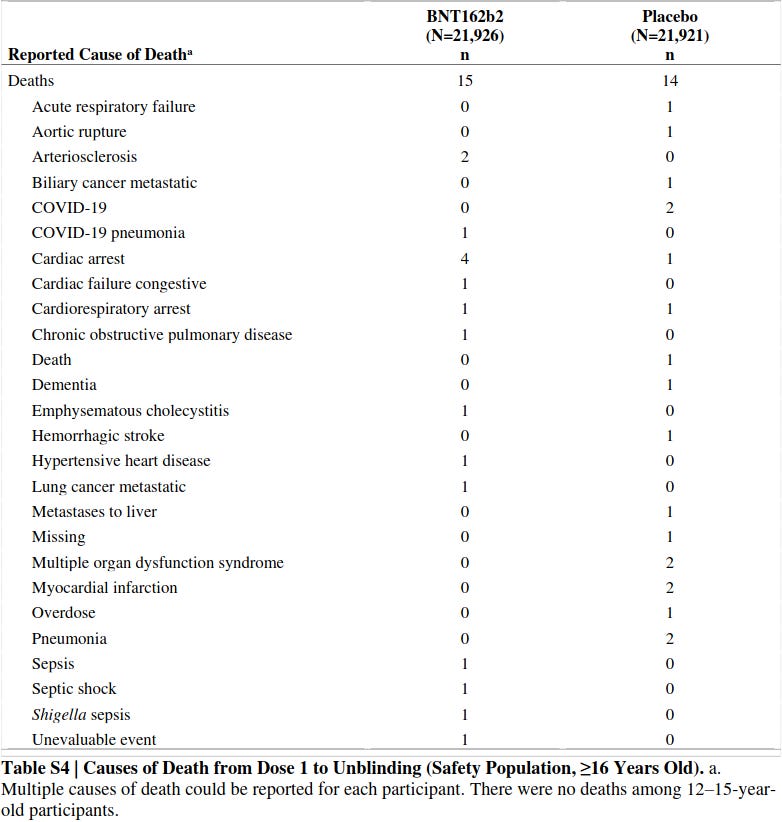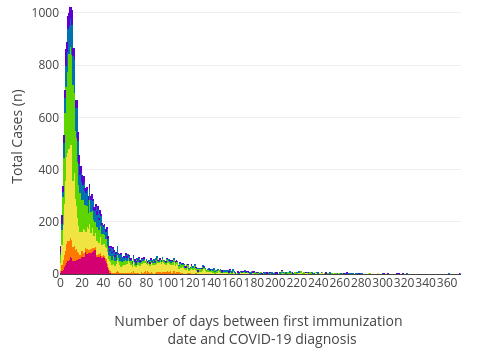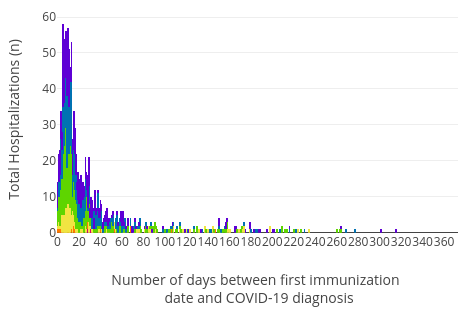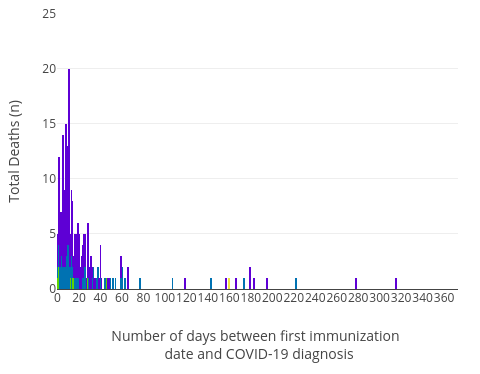In Part 1 of this mini-series, I summarised the data indicating that since the roll-out of the experimental medical interventions usually labelled “COVID-19 vaccines” began, the death rates from both COVID- and non-COVID-related causes have gone up, with the most dramatic increase in deaths occurring in younger adults.
There are, of course, many potential explanations for this observed rise in deaths, including:
Inappropriate treatment of COVID-19 (including people who “tested positive” without showing any symptoms of respiratory illness, but were nonetheless prescribed remdesivir which is both ineffective and dangerous), that is resulting in an increased death rate despite progressive reduction in the virulence of the virus;
Delayed effects of SARS-CoV-2 infection in those who fell ill but recovered (most of them without the benefit of early effective treatment);
Ongoing effects of the policy responses to COVID-19 that resulted in delayed medical care of non-COVID illnesses and resulted in profound psychological harms, social disruption and economic hardship;
The injections increase the risk of SARS-CoV-2 infection, in turn increasing the risk of death from COVID-19;
The injections cause deaths from non-COVID causes.
None of these potential contributing factors are mutually exclusive, and their effects may be – and probably are – synergistic.
However, in Part 2, I’m going to present multiple pieces of evidence that the COVID-19 injections have played a significant, direct causal role in these increased death rates.
Before I lay out those pieces of evidence, let’s talk about the Bradford Hill criteria, otherwise known as Hill’s Criteria for Causality. Sir Austin Bradford Hill proposed nine aspects of an association between two phenomena that should be considered in attempting to distinguish causal from noncausal associations:
Strength - strong associations between two phenomena are more likely to be causal than weak associations, while weak associations are more easily explained by undetected biases
Consistency - if an association is found by different observers, in different populations under different circumstances, it is more likely to be causal
Specificity - a cause leads to a single effect, not multiple effects; this criterion is now widely regarded as useless and misleading as there are so many counterexamples, such as cigarette smoking which leads to multiple effects on different organs and tissues
Temporality - the cause must obviously precede the effect in time
Biologic gradient - a higher dose of the cause is usually expected to produce a stronger effect (monotonic dose-response curve), although there are many exceptions
Plausibility - there must be a biologically plausible route by which the cause results in the effect
Coherence - a cause and effect interpretation for an association must not conflict with what is known of the natural history and biology of the disease (although sometimes what is believed to be known about the biology of the disease is later shown to be wrong)
Experimental evidence - the causal hypothesis can be tested through experiment
Analogy - similarities exist between the observed association and any other associations.
Keep the Bradford Hill criteria in mind as we work our way through the evidence.
1. The Pfizer/BioNTech clinical trial showed more deaths in the injection group than the placebo group
As Peter Doshi, Associate Editor of The BMJ pointed out in October 2020,
“None of the trials currently under way are designed to detect a reduction in any serious outcome such as hospital admissions, use of intensive care, or deaths.”
Will covid-19 vaccines save lives? Current trials aren’t designed to tell us
You read that correctly. While politicians, health bureaucrats and media talking heads rapturously spruiked these novel products as “lifesaving vaccines” from the get-go, none of the phase 3 trials for COVID-19 injections were designed to ascertain whether these products reduced the frequency of the outcomes that the people who were eventually going to be seduced, cajoled and coerced into taking them actually cared about – severe disease, hospitalisation and death… and also viral spread:
“Nor are the vaccines being studied to determine whether they can interrupt transmission of the virus.”
Will covid-19 vaccines save lives? Current trials aren’t designed to tell us
As Doshi explained, the manufacturers of COVID-19 injections, and the contract research organisations they hire to carry out the trials, hold all the data on these clinical trials, and none has released full datasets for independent evaluation.
However, when Pfizer published its six-month safety and efficacy data in order to gain FDA approval for its Comirnaty injection, a rather startling fact emerged: More people who were randomised to receive the Pfizer injection died during the trial than people randomised to receive the saline placebo injection.
Whilst 1 out of the 21,926 participants who received two Pfizer injections were recorded as dying of “COVID-19 pneumonia”, 2 out of the 21,921 participants who received two placebo injections were recorded as dying of “COVID-19”.
Even this linguistic nit-picking in assigning cause of death raises suspicions; if two people died “of” COVID-19 without developing pneumonia, how exactly did COVID-19 cause their deaths? We can’t tell, because Pfizer hasn’t released the clinical data.
But setting this aside, according to its own clinical trial, the Pfizer product reduced the risk of dying of COVID-19 from 0.009% to 0.004%. So that’s exciting.
On the other hand, Pfizer reported 15 total deaths in those who received the “vaccine”, versus 14 deaths in those who received the placebo (see Table S4 in the Supplementary Materials):
However, Pfizer told the FDA a rather different story. In its ‘Summary Basis for Regulatory Action’, FDA reported that in the same period in which Pfizer had publicly announced 15 deaths in the “vaccine” group and 14 deaths in the placebo group,
“There were a total of 38 deaths, 21 in the COMIRNATY group and 17 in the placebo group.”
Caveats apply to interpretation of these data, of course. The overall numbers of deaths were small, and the deaths that occurred in the injection recipients cannot be definitively linked to the injection itself.
Nonetheless, the fact that the death rate was 24% higher in people who received the injection than the placebo, should give pause for thought, especially given the vanishingly small risk of dying of COVID-19 that the trial itself documented. Dying of COVID-19 isn’t better than dying of any other cause. Dead is dead.
2. A Big Data analysis of 145 countries indicates that COVID-19 injections have increased the number of people dying of COVID-19
Bayesian analysis is a statistical technique that uses evidence to update the state of uncertainty over competing probability models. In laymen’s terms, it makes use of big gobs of data about Thing A and Thing B to get closer and closer to being sure that Thing A caused Thing B rather than merely being associated with it.
Using data downloaded directly from Our World in Data and the software package CausalImpact, study author Kyle A. Beattie found that in 87% of the 103 countries for which statistically significant data were available, there was an increase in total cases of COVID-19 per million after injections were introduced.
Furthermore, in 90% of the 128 countries for which statistically significant data were available, there was an increase in total deaths per million associated with COVID-19 after injections were introduced.
In a nutshell: It is highly probable that the introduction of COVID-19 injections into a population leads to more cases and more deaths.
And tragically, the countries with the lowest COVID-19 death toll pre-injection had the biggest increase in COVID-19 deaths after the injection roll-out began:
“Countries with few COVID-19 deaths in the year 2020 appear to have fared the worst of all countries after vaccine administration (e.g Thailand, Vietnam, Mongolia, Taiwan, Seychelles, Cambodia, etc.). The causal impact results from vaccine administration seen in these countries of hundreds or thousands of percentage increases in total deaths and cases per million are also the causal impact results we can be most statistically confident in due to the direct increase of COVID-19 associated deaths and cases after vaccine administration, where prior to vaccine administration there were few or none.”
Fiji suffered an eye-popping 2499% increase in COVID-19 deaths per million after they began injecting their population, Seychelles a staggering 10,680% increase, and Mongolia an unfathomably tragic 19,015% increase.
3. COVID-19 cases and deaths spike after people receive their first injection
If COVID-19 injections had no association with serious illness and death, we would not expect to see hospitalisations for, and deaths from, COVID-19 clustering tightly in the days and weeks following them. But that’s exactly what was seen in the Canadian province of Alberta… at least until investigative journalist Alex Berenson notified the public and the government took down the charts.
Luckily, a previous version of the page was archived before the Canadian corruptocrats memory-holed it, so we can see what they wanted to hide.
Cases after first injection:
Hospitalisations after first injection:
Deaths after first injection:
Purple represents people aged over 75, blue 60-74, green 40-59, yellow 20-39, orange 12-19 and red under 12; it’s obvious that the injections are most deadly in the age group most vulnerable to COVID-19 – the elderly.
As Berenson points out, the same phenomenon was observed in the UK, where the highest COVID-19 death toll per capita of any large country at any stage during the pandemic occurred in January 2021, as the Brits began jabbing their elderly people.
The most likely explanation is the transient drop in lymphocyte counts that occurs after the first injection (lymphocytopoenia), which is known to increase the risk of infection in general.
According to a Danish study of nursing home residents and health care workers who received the Pfizer shot, vaccine efficacy in the first 14 days after the first shot was -40% for the residents and -104% for the workers. That is, the old folk were 40% more likely to be diagnosed with COVID-19 in the 14 days after their first shot than if they remained uninjected, and the health care workers were more than twice as likely.
Low lymphocyte counts have also been found to correlate with greater severity of COVID-19 – a real double-whammy for those exposed to SARS-CoV-2 during a period in which their antiviral immune defence is reduced, and even more so if they’re immunocompromised due to immunosenescence (age-related decline in immune function) and/or pre-existing illness.
Note that most jurisdictions, including Australia, count people as “unvaccinated” until they are 14 days past their first shot. No wonder – doing this allows them to bury the data on negative vaccine efficacy in the first 2 weeks as well as deflecting attention away from the possibility that people who have just received their first injection may be SARS-CoV-2 superspreaders because if they become infected whilst their immune system is suppressed, they will be more likely to have a high viral load and therefore to shed infectious virus.
4. All-cause and non-COVID mortality also rise after the first injection
Analysis of week-by-week all-cause mortality data from Europe and Israel found that all-cause mortality spikes in the 5-6 weeks after the first injection, then falls in the 6-20 weeks following the first injection (correlating with the brief window of time in which there appears to be a protective effect against infection and hospitalisation for COVID-19), then begins to rise again in people aged 15-64.
In the US, which has less granular data on mortality than Europe and Israel, the number of administered injection doses in both the prior month and current month predicted monthly total deaths in most age groups, with more excess deaths occurring in the elderly (over 75) in the first half of the year, and in younger people in the second half of the year – directly paralleling the age-stratified roll-out of the injections.
Using a number of different models and thresholds, the authors estimated that somewhere between 133,382 and 187,402 vaccine-associated deaths occurred in the US from February to August of 2021.
They calculated the average vaccine fatality rate (VFR) across the US as 0.04% (4 deaths per 10,000 doses administered), with age-adjusted VFRs of 0.004% for ages 0-17 years, 0.005% for 18-29 years, 0.009% for 30-39, 0.017% for 40-49, 0.016% for 50-64, 0.036% for 65-74, 0.06% for 75-84, and 0.055% for 85-plus.
Intriguingly, both the European and US data revealed that mortality in children aged 0-14 (who were unvaccinated during the time period analysed) also rose in lockstep with weekly increases in percentages of the total population who received at least one injection, up until week 18 post injection, with the majority of child deaths occurring in babies under 1 year of age.
The authors propose “indirect adverse effects of adult vaccination on mortality of children of ages 0-14 during the first 18 weeks after vaccination”. These indirect effects could include:
Transmission of injection-induced spike protein “by inhalation or skin contact”, as warned of in Pfizer’s clinical trial protocol document;
Transmission of either injection-induced spike protein and/or components of the injection through the breast milk of an injected mother (see VAERS reports here and here);
“Vaxidents” – post-injection traffic accidents attributed to mini-strokes and blood clots in the brain; the US Department of Transportation’s National Highway Traffic Safety Administration reported that motor vehicle crash fatalities in January-June 2021 surged 18.4% above the 2020 figures, the largest six-month increase ever recorded in the Fatality Analysis Reporting System’s history.
5. UK data shows the injected are dying at a higher rate than the uninjected
Even with a host of discrepancies and inconsistencies in the UK data that slant all-cause mortality rates in favour of the injected, those who have received at least one dose are still dying at a higher rate than those who remain injection-free.
6. Reports of deaths following COVID-19 injections are higher than for any previous vaccines
As previously described, reports of deaths following COVID-19 injections to national and international pharmacovigilance systems – including DAEN in Australia, VAERS in the US, EUdraVigilance in Europe and the Yellow Card system in the UK – are dramatically higher than for any previous vaccine.
For example, the average number of deaths following vaccination reported to VAERS for the past 10 years has been about 155 each year, for all vaccines combined. As of January 20, 2022, 21,745 deaths after COVID-19 injections have been reported to VAERS, since the roll-out began in late December 2020. That’s roughly 140 times as many deaths reported after COVID-19 injections as after all the other vaccines put together.
And, also as previously described, most adverse reactions to vaccines are not reported, and we need to multiply these death reports by anywhere from 5 to over 100 to reach a reliable estimate of just how many people have died after receiving a COVID-19 injection.
7. There is a disproportionate number of cardiovascular and cerebrovascular deaths after COVID-19 injections and there are biologically plausible mechanisms linking the injections to the deaths
Analysis of 196 death cases reported after the Pfizer injection in Japan revealed that a disproportionately high number of these deaths were from cardio- and cerebrovascular diseases, including stroke, myocardial infarction (heart attack), venous thrombosis and pulmonary embolism and heart failure.
For example, of 31 deaths occurring in injected vaccinated medical workers, 84% were cerebro- and cardiovascular diseases, compared to only 22% in the general population. Of the reported death cases in elderly people, 69% were from cerebro- and cardiovascular causes, compared to 26% in the general population.
The authors of the analysis point out that post-injection deaths reach a peak on 4 days post injection, which is also the median incubation period of COVID-19. They posit that when injection-induced spike proteins attach themselves to the delicate endothelial cells which line our blood vessels, they are recognised as foreign bodies by the immune system, and are attacked and eliminated. This causes damage to the endothelium, triggering blood coagulation and thrombus (clot) formation which can in turn cause a heart attack or stroke. Serious damage to the endothelium can trigger dissecting aneurysm or rupture of a small aneurysm.
8. Highly experienced pathologists have judged between 30% and 93% of post-injection deaths to have been caused by COVID-19 injections, based on autopsy findings
After conducting autopsies on 40 people who died within two weeks of receiving a COVID-19 injection, Peter Schirmacher, chief pathologist at the University of Heidelberg, concluded that 30-40% of them died as a direct result of the injection.
Schirmacher, who is injected himself and a proponent of the injections, has publicly stated that the frequency of fatal vaccination consequences is underestimated. He has called for more autopsies of people who die after injection to be conducted in order to clarify the mechanism(s) of harm, which will enable doctors to tailor their advice to their patients based on risk factor profiles. (Dr Schirmacher does not discuss how this individualised advice squares with one-size-fits-all mandates.)
Dr Arne Burkhardt , one of the most experienced pathologists in Germany, and retired Thai-German microbiologist Dr Sucharit Bhakdi (read their extensive and impressive bios here) conducted autopsies on 15 people (aged between 28 and 95) who died between 7 days and 6 months after receiving a COVID-19 injection, and concluded that the injection was implicated in the deaths of 14 of the 15 cases.
They observed widespread inflammatory events in small blood vessels (endothelitis), and extensive accumulation of T lymphocytes in non-lymphatic organs, indicating that the immune systems of the deceased individuals were attacking their own organs – especially the heart and lungs.
Burkhardt and Bhakdi presented their findings at a press conference which can be viewed here, with a concise version presented by Dr Bhakdi here.
Back to the Bradford Hill criteria
I think it’s fair to say, after reviewing the evidence laid out above, that there is a strong, consistent, temporal relationship between COVID-19 injections and death, that is biologically plausible and coherent, and borne out by natural experiments (such as the introduction of COVID-19 injections into populations that previously had zero or low COVID-19 deaths).
The specificity criterion is now considered to be of limited value; the biologic gradient criterion has limited applicability and the analogy criterion is rendered largely moot by the sheer scale of COVID-19 injection-associated deaths, which dwarf those associated with any other pharmaceutical product.
In a sane world, responsible medical authorities would call an immediate halt to the COVID-19 injection program and conduct a forensic (literally) examination of the massive volume of injuries and deaths associated with these novel pharmaceutical products.
Instead, we are being ordered to take boosters of the same products that have self-evidently failed to “end the pandemic” and could quite possibly be making it worse.
What are we to make of that failure to act in the face of these obvious harms and abject failures? I’m interested in your thoughts; please share them in the Comments section below.








Great Posts, impossible to comprehend how people think, when at times they agree with reasons you point out to them not to take a risk and then go ahead and get the third shot, commenting I won’t get another one and in other cases I have had a good life, have to die of something. Penned a little poem below, might explain somewhat how I feel.
WHY
Is it unreasonable to question why
When law breakers create pressure to comply
Is it for the good of thy
Or is it for some power up high
Sickness is not a welcome friend
Let people chose the way to mend
For in this fight the way may vary
As human kind is quite contrary
Promote protocols to prepare One’s body
Not mandates for vaccines that may be shoddy
The right to chose is enshrined in law
The Nuremberg Code abused, like never before
Is this a scheme to create a divide
Splitting families and communities far and wide
We have Eminent Professionals over the world wide
Telling Governocrats, don’t go and hide
Bring true information out into the open
Let all small business, now reopen
Lock downs and masks bring no cheer
Maybe it’s a programme to promote more fear
Experimental Vaccines not approved by the TGA
Approved by Government any old way
Whether Covid 19, vaccinated or not
You can still catch and spread this terrible lot
Social distancing they say, keeps the virus away
But jump on a plane, no virus no way
Publicised advice is supposed to be clinical
Contradictions Abounding, it’s hard not be Cynical
Now we have the Omricon
The virus spirals on and on
A rapidly spreading new viral strain
Alas, one that causes far less pain
As we face this new found bout
History suggests that it is fading out
At present we are in Summer season
So why not face this with some reason
Why not have respect for All
Whether or not you want to play Ball
Why not respect each person’s call
It’s just not right to push till they fall
As I look out at the Summer Sky
I ponder decisions for division and wonder WHY
Gavin Hanrahan 22.02.2022
“"Among all the vaccines I have known in my life (diphtheria, tetanus,measles, rubella, chickenpox,hepatitis, meningitis and tuberculosis), I want to also add flu and pneumonia. I have never seen a vaccine that forced me to wear a mask and maintain my social distance, even when you are fully vaccinated. I had never heard of a vaccine that spreads the virus even after vaccination. I had
never heard of rewards, discounts, incentives to get vaccinated. I never saw discrimination for those who didn't. If you haven't been vaccinated no one has tried to make you feel like a bad person. I have never seen a vaccine that threatens the relationship between family, colleagues and friends. I have never seen a vaccine used to threaten livelihoods, work or
school. I have never seen a vaccine that would allow a 12-year-old to override parental consent.
After all the vaccines I listed above, I have never seen a vaccine like this one, which discriminates, divides and judges society as it is. And as the social fabric tightens… It's a powerful vaccine! She does all these things except IMMUNIZATION.
If we still need a booster dose after we are fully vaccinated, and we still need to get a negative test after we are fully vaccinated, and we still need to wear a mask after we are fully vaccinated, and still be hospitalized after we have been fully vaccinated, it will likely come to “It's time for us to admit that we've been completely deceived.😢”
Copied and pasted .. with love ✨💖✨”